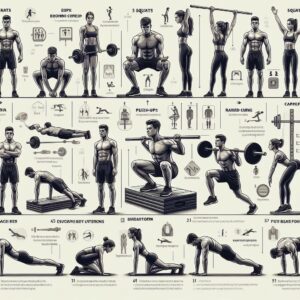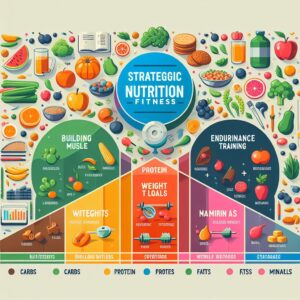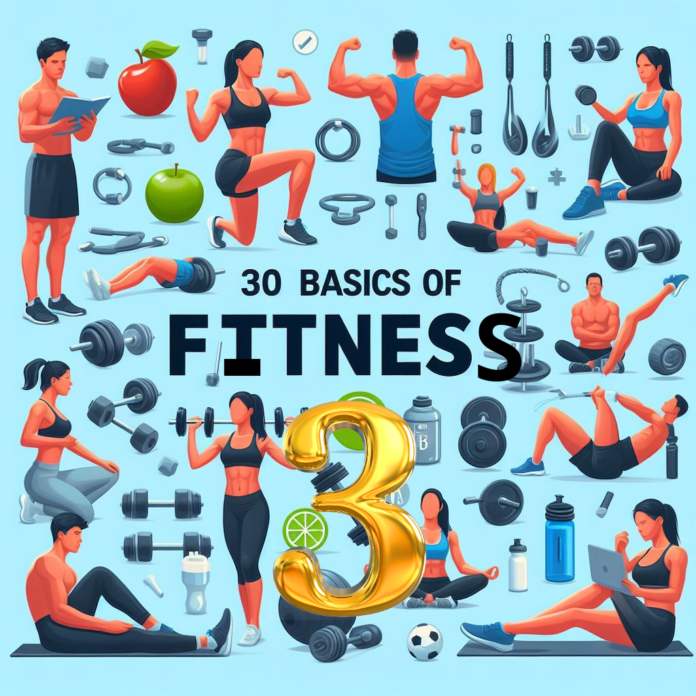Embarking on a fitness journey is a transformative experience that extends beyond the confines of physical health. It is an exploration of personal potential, a test of discipline, and a gateway to holistic well-being. In today’s fast-paced world, where stress and sedentary lifestyles are prevalent, embracing fitness is not merely a choice but a necessity. However, for beginners, the vast expanse of fitness knowledge can be overwhelming. From understanding the basics of exercise to mastering nutrition and managing mental well-being, the path to fitness is multifaceted.
This comprehensive guide is designed to demystify the journey, providing beginners with a solid foundation and actionable strategies to embark on their fitness journey with confidence. It covers the importance of technique, the significance of listening to your body, the integration of flexibility and mobility, the role of mental well-being, the joy of the journey, strategic nutrition, and essential tips for a successful nutritional strategy. By the end of this part of the guide, you will be equipped with the knowledge and tools to transform your fitness journey into a rewarding and sustainable lifestyle.
I. The Importance of Technique:

The significance of adopting proper technique during physical exercises cannot be underestimated, both for beginners and seasoned athletes. This rigorous approach is key to achieving fitness goals efficiently and safely. Here’s why and how proper technique plays a central role in any exercise routine.
1. Maximizing Efficiency:
Mastering the correct technique ensures that each movement produces maximum efficiency. This means that for the same investment in time and energy, the athlete or individual engaging in physical activity can achieve superior results.
For example, proper posture and body alignment during a weightlifting exercise maximize the activation of targeted muscles, thus increasing strength and muscle mass more significantly.
2. Minimizing Injury Risks:
One of the most critical benefits of good exercise techniques is the substantial reduction in the risk of injuries. Incorrect or unnatural movements can put excessive pressure on muscles, tendons, and joints, leading to pain, strains, or even severe injuries. For example, a poorly executed squat can put undue pressure on the knees and back, while a correct technique protects these areas by distributing the effort evenly.
3. Improving Breathing:
Proper technique also encompasses breathing management, which plays a crucial role in performance and endurance. Breathing correctly during exercise enhances blood oxygenation and energy efficiency, allowing for prolonged effort and quicker recovery. A coach’s instructions can help you synchronize your breathing with your movements, a skill often overlooked by amateur athletes.
4. Consulting Experts:
For those starting or looking to refine their technique, it is highly recommended to consult a professional. Certified trainers, with their expertise, can provide personalized assessments, correct posture and movement errors, and develop training plans tailored to each individual’s needs and goals. These experts can also recommend adjustments to accommodate physical restrictions or pre-existing injuries, ensuring a safe and adapted sports practice.
Investing time and resources in mastering proper exercise techniques is essential for safe and effective physical practice. Not only does it maximize the benefits of each workout session, but it also significantly reduces the risk of injuries. Consulting certified trainers enriches the exercise experience, providing valuable guidance that helps achieve fitness goals smartly and sustainably.
II. Listening to Your Body:

Paying close attention to your body is a crucial pillar in the quest for optimal physical fitness and overall well-being. The ability to correctly interpret bodily signals plays a critical role in injury prevention, effort management, and maximizing the benefits of each workout session. Here’s a deeper exploration of the importance of aligning with your body’s signals and strategies for developing this vital skill.
1. Recognizing Body Signals:
– Understanding Pain:
It’s essential to distinguish between different types of pain experienced during and after exercise. Mild to moderate pain and a burning sensation in the muscles during intense training are normal; they indicate that the muscles are being pushed to their limits, which is crucial for the development of strength and endurance. On the other hand, sharp, throbbing pain, or discomfort that lingers well after exercise, may signal an injury or underlying issue requiring medical attention.
– Listening to Fatigue:
Your energy level is another crucial indicator of your overall health and ability to endure intense workout sessions. Ignoring excessive fatigue can lead to overexertion, overtraining, and a decrease in long-term performance. Therefore, it’s essential to adjust the intensity and duration of your workouts based on your available energy, ensuring to incorporate adequate rest and recovery periods.
2. Body Listening Strategies:
– Workout Journal:
Keeping a workout journal, including notes on your fatigue levels, pains experienced, and overall state can help you better understand your body’s reactions to different types of exercises and adjust your routines accordingly.
– Integrating Mindfulness:
Mindfulness and meditation techniques can enhance your ability to be attentive to your body’s signals. Practices such as yoga or tai chi, which emphasize the body-mind connection, can also help develop a better awareness of your body.
– Professional Consultation:
It’s advisable to regularly consult health professionals, such as physiotherapists, personal trainers, or sports medicine doctors. These experts can offer personalized advice based on your body’s reactions to exercise, helping you prevent injuries and optimize your performance.
Learning to listen and correctly interpret your body’s signals is an indispensable skill for anyone engaged in an exercise routine. This ability not only helps avoid injuries and overexertion but also contributes to a faster and more sustainable progression toward your fitness goals.
III. Incorporating Flexibility and Mobility:

Integrating flexibility and mobility into a workout program often goes beyond the usual concerns of fitness enthusiasts, who tend to focus primarily on strength, endurance, or weight loss. However, these aspects are crucial for comprehensive physical fitness, enhancing not only the range of motion but also contributing to better athletic performance and a significant reduction in the risk of injuries. Here’s a detailed exploration of the importance of flexibility and mobility, along with tips for effectively incorporating them into your workout routine.
1. Why Flexibility and Mobility are Crucial?
– Improving Range of Motion:
Flexibility, or the ability of your muscles to stretch, and mobility, the ability of joints to move freely, are fundamental for a good range of motion. A better range of motion allows for performing exercises with better form, increasing the efficiency of the training and minimizing the risk of injuries related to poor technique.
– Enhancing Performance:
Flexibility and mobility contribute to better performance by allowing more fluid and efficient movements. Whether you are a runner, swimmer, cyclist, or competitive sportsperson, good mobility can significantly improve your technique and, consequently, your results.
– Reducing Pains and Injuries:
A routine that includes flexibility and mobility exercises can help prevent chronic pains, particularly in the back and joints. By regularly stretching muscles and working on joint mobility, you can decrease the risk of muscle strains, tears, and other common fitness injuries.
2. How to Integrate Flexibility and Mobility?
– Yoga and Pilates:
Yoga and Pilates are excellent practices for improving both flexibility and mobility. These disciplines emphasize controlled movements, specific postures, and breathing, thus contributing to strengthening deep muscles, improving balance, and increasing the range of motion in joints.
– Specific Stretching:
Incorporating a stretching routine before and after your workout sessions can significantly improve your flexibility. Dynamic stretches are particularly useful before exercise to prepare muscles and joints, while static stretches after the workout help release muscle tension and improve long-term flexibility.
– Joint Mobility:
Exercises specifically targeting joint mobility, such as rotations, extensions, and flexions, can be integrated into your warm-up or practiced separately. These movements help maintain and enhance joint fluidity, essential for all physical activities.
Regularly including exercises for flexibility and mobility in your workout routine is indispensable for overall physical fitness and injury prevention. By adopting practices such as yoga, Pilates, and targeted stretching sessions, you can not only improve your range of motion and performance but also contribute to a better quality of life by reducing the risk of pain and exercise-related injuries. A commitment to flexibility and mobility is an investment in your long-term health and well-being.
IV. Managing Stress and Mental Well-being:

Managing stress and promoting mental well-being are essential components of a holistic health approach, where physical exercise plays a central role not only as a tool for the body transformation but also as a powerful modulator of mood and mental state. Beyond its well-documented effects on physical fitness, regular physical activity is an effective lever against stress, anxiety, and depression, offering a beneficial escape from daily routine and worries. Let’s take a closer look at how and why integrating physical activity into your life can contribute to a significant improvement in your mental well-being.
1. The Link Between Physical Exercise and Mental Well-being:
– Stress Reduction:
Physical exercise stimulates the production of neurotransmitters, such as endorphins, often called “happiness hormones,” which play a key role in reducing pain perception and promoting a sense of well-being. Additionally, physical activity can reduce cortisol levels, a hormone commonly associated with stress.
– Combating Anxiety and Depression:
Numerous studies have shown that regular exercise can have an effect comparable to that of antidepressants for some people suffering from depression or anxiety, thanks to the improvement in neurotransmitter regulation and the increase in neurogenesis (the creation of new neurons in the brain).
– Improving Sleep Quality:
Physical exercise can also contribute to improving the quality and duration of sleep, which, in turn, supports better stress management and increased mental well-being. Regular physical activity helps regulate circadian rhythms, promoting a more natural and restorative sleep cycle.
2. Strategies for Integrating Exercise into Stress Management:
– Find an Activity You’re Passionate About:
Adherence to a long-term exercise program is strongly influenced by the pleasure you find in it. Whether it’s running, yoga, swimming, or cycling, choosing an activity that brings you joy is crucial for maintaining the regularity of your practice.
– Vary Your Routines:
Varying your physical activities can not only prevent boredom but also stimulate different muscle groups and systems in the body, optimizing the benefits for physical and mental health.
– Listen to Your Body:
It’s important to stay attuned to your body and adjust your activity level according to your current needs and capabilities. On days when you feel less energetic, gentler activities like walking or gentle yoga may be more appropriate.
– Incorporate Mindfulness:
Incorporating elements of mindfulness into your exercise routine, such as focusing on your breathing during yoga or meditating after a running session, can amplify the beneficial effects of exercise on mental well-being.
Physical exercise is a powerful and underutilized tool in managing stress and promoting mental well-being. By adopting a mindful and personalized approach to physical activity, you can not only improve your physical fitness but also enrich your mental and emotional health, contributing to an overall improved quality of life. The key is to find a balance that works for you, integrating physical activities that bring you both pleasure and relaxation and staying attuned to the needs of your body and mind.
V. Joy in the Journey:

Finding joy in the fitness journey is essential to transform exercise from a chore into an integral and jubilant part of your daily routine. It’s the key to developing a lasting relationship with fitness, beyond the fluctuations of motivation or immediate results. Instead of focusing solely on the end goal, such as losing weight or gaining muscle, the real magic lies in appreciating the journey itself. Here’s how to infuse joy into your fitness journey and additional dimensions to enrich your experience and solidify your commitment to an active lifestyle.
1. Celebrate Every Small Victory:
– Acknowledging Progress:
Take stock of the small victories, whether it’s adding a few pounds to your weight lift, extending your running distance, or simply feeling more energetic day-to-day. Every progress, no matter how minor, is a step towards your ultimate goal and deserves celebration.
– Fitness Journal:
Keeping a fitness journal where you log your workouts, progress, and even your moods can help you visualize your evolution and find satisfaction in gradual improvements.
2. Explore and Experiment:
– Activity Diversity:
Don’t hesitate to experiment with different forms of physical activities. Diversity can not only prevent boredom but also allow you to discover new passions. From paddleboarding to parkour, each activity offers the opportunity to explore different facets of your physical and mental fitness.
– Learning New Skills:
Each new skill acquired, whether it’s a more efficient swimming technique or a complex yoga pose, is a source of personal satisfaction and enhances your sense of achievement.
3. Social Integration:
– Training Groups and Sports Clubs:
Joining training groups or sports clubs can not only motivate you but also allow you to share your passion with like-minded individuals. These communities offer support, encouragement, and sometimes healthy competition.
– Events and Challenges:
Participating in local sports events or online challenges can add a playful element to your training, pushing you to excel while having fun.
4. Mindfulness and Body-Mind Connection:
– Listening to Your Body:
Be attuned to your body’s signals and adjust your training according to your physical and mental needs at the moment. This may mean slowing down or changing the type of exercise when necessary.
– Meditation and Yoga:
Incorporating practices like meditation and yoga can enrich your fitness experience by establishing a deeper connection between body and mind, thereby increasing the overall sense of well-being.
The pleasure found in the fitness process is a powerful driver of motivation and commitment. By celebrating every victory, exploring new activities, connecting socially, and establishing a body-mind connection, you can transform your fitness journey into a joyful and enriching adventure. When physical activity becomes a source of pleasure, it naturally integrates into your life, promoting a long-term active and healthy lifestyle.
VI. Strategic Nutrition:

Strategic nutrition is a crucial pillar for maximizing the benefits of your training program and efficiently achieving your fitness goals. This approach goes beyond merely eating healthily; it requires a deep understanding of how different nutrients impact your body, performance, and recovery. Here’s a detailed guide to optimizing your nutrition according to your physical activities, highlighting the importance of proteins, carbohydrates, hydration, and dietary supplements.
1. The Importance of Proteins:
Proteins play a crucial role in repairing and rebuilding damaged muscle fibers during training. Consuming an adequate amount of protein after your exercise sessions accelerates muscle recovery, promotes muscle growth, and improves overall strength.
– When to Consume: It is recommended to consume proteins within an hour after your workout to take advantage of the anabolic window, a period when your body is particularly receptive to using proteins for muscle repair.
– Protein Sources: Opt for complete protein sources like meat, fish, eggs, dairy products, or plant-based protein-rich alternatives like lentils, chickpeas, and tofu.
2. The Role of Carbohydrates:
Carbohydrates are your primary energy source during exercise. Consuming carbohydrates before training can enhance performance and extend endurance, while replenishing them after exercise helps restore muscle glycogen stores, essential for recovery.
– When to Consume: A carbohydrate-rich meal or snack 1 to 3 hours before training ensures sufficient energy. After exercise, carbohydrates are also important for replenishing glycogen levels.
– Carbohydrate Sources: Favor complex carbohydrates like whole grains, fruits, vegetables, and legumes, which provide a more stable energy release.
3. Hydration:
Hydration is fundamental for optimal body functioning, especially during and after exercise. Adequate hydration regulates body temperature, transports necessary nutrients to cells, and helps eliminate metabolic waste.
– Recommended Water Intake: Although needs vary based on factors like climate and exercise intensity, aim for at least 2 liters of water per day, increasing this amount on training days.
4. Dietary Supplements:
For some, dietary supplements can play a role in enhancing performance and recovery. However, they should not replace a balanced and varied diet.
– Wise Selection: Supplements like protein powder, BCAAs (branched-chain amino acids), creatine, and multivitamins can be useful, but it is crucial to choose high-quality products and consult a healthcare professional before incorporating them into your routine.
Adopting a nutritional strategy tailored to your training needs is fundamental to support your physical performance, accelerate recovery, and achieve your fitness goals. By paying attention to protein intake, and carbohydrates, maintaining adequate hydration, and considering the judicious use of dietary supplements, you can significantly enhance your fitness experience and overall well-being. The key is to listen to your body and adjust your nutrition according to your physical activities and specific goals.
VII. Tips for a Successful Nutritional Strategy:

To enrich your nutritional strategy and optimize your fitness journey, here are some essential points to consider, which can improve your overall health, maximize your performance, and support your recovery.
1. Nutritional Timing:
The timing of your nutritional intake can have a significant impact on your performance and recovery. In addition to the post-workout anabolic window for proteins and carbohydrates:
– Breakfast: Do not underestimate the importance of a nutritious breakfast to provide the energy needed for the day’s activities, especially if you train in the morning.
– Meal Distribution: Instead of three large meals, consider distributing your nutritional intake into several small meals throughout the day to maintain energy levels and facilitate digestion.
2. Micronutrients:
Vitamins and minerals, although required in smaller amounts than macronutrients, play crucial roles in many bodily functions, including maintaining a healthy immune system, cell repair, and protein synthesis.
– Fruits and Vegetables: Increase your consumption of fruits and vegetables to ensure adequate intake of vitamins, minerals, and fiber.
– Selective Supplementation: In case of deficiencies identified by medical tests, targeted supplementation may be necessary. For example, vitamins D and B12, iron, and omega-3s are nutrients commonly supplemented.
3. Weight Loss and Muscle Gain Management:
Adjusting your calorie intake based on your fitness goals is crucial:
– Caloric Deficit for Weight Loss: To lose weight, it’s necessary to consume fewer calories than your body expends. However, ensure that this reduction does not compromise your essential nutritional intake.
– Caloric Surplus for Muscle Gain: If your goal is muscle gain, a slight caloric surplus, combined with resistance training, can help promote muscle growth.
4. Rest and Recovery:
Nutrition plays a role in rest and recovery, not just through what you eat, but when you eat:
– Sleep: Avoid heavy meals and stimulants like caffeine just before bedtime to avoid disrupting your sleep.
– Active Recovery: On active recovery days, adjust your nutritional intake to support low-intensity activities, such as walking or yoga, that aid in muscle recovery.
5. Listening to Your Body:
– Individual Responses: Be attentive to how your the body responds to different foods and timings. Personalizing your diet based on these responses can enhance your health and performance.
– Hydration: Monitor the color of your urine to assess your hydration status and adjust your water intake accordingly.
By incorporating these tips into your nutritional strategy, you’ll be better equipped to support your fitness journey, improve your overall health, and achieve your goals. Nutrition, when approached strategically and personalized, can become a powerful ally in your quest for an active and fulfilling lifestyle.
Conclusion:
Embarking on a fitness journey is a commendable endeavor that promises a myriad of benefits for both body and mind. This comprehensive guide has provided a roadmap for beginners, covering the essential aspects of fitness, from technique and body awareness to nutrition and mental well-being. As you embark on this journey, remember that fitness is not a destination but a continuous journey of self-discovery and improvement. Celebrate every small victory, embrace the challenges, and find joy in the process. By integrating the principles outlined in this guide, you will not only achieve your fitness goals but also enhance your overall quality of life. Stay committed, stay motivated, and let the journey to a healthier, happier you begin.

